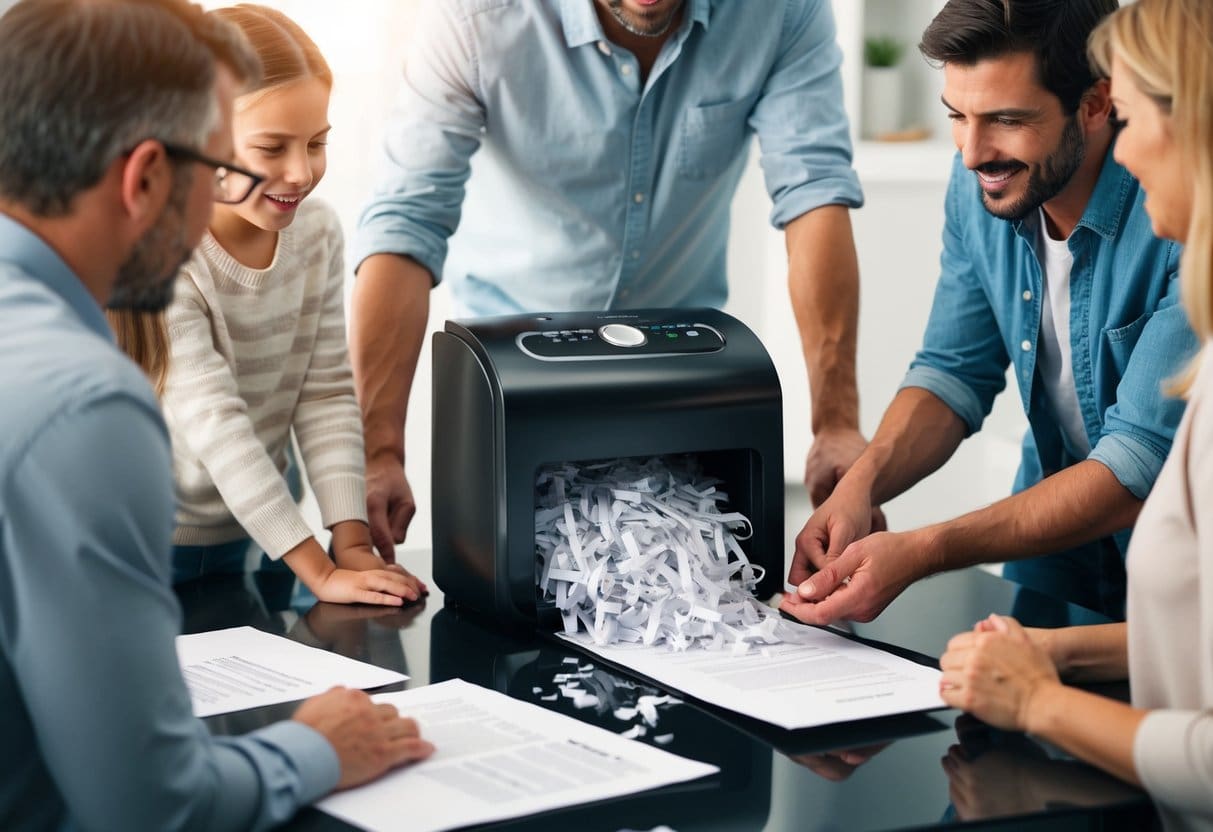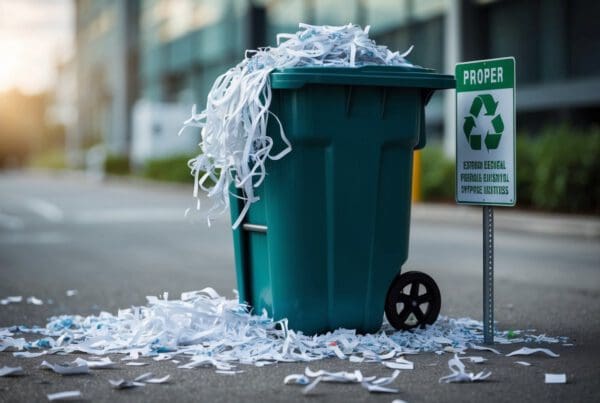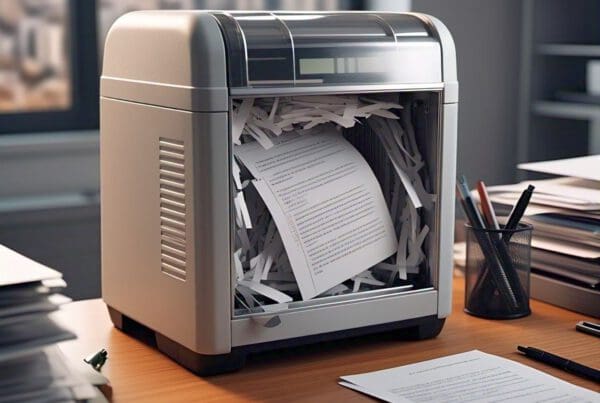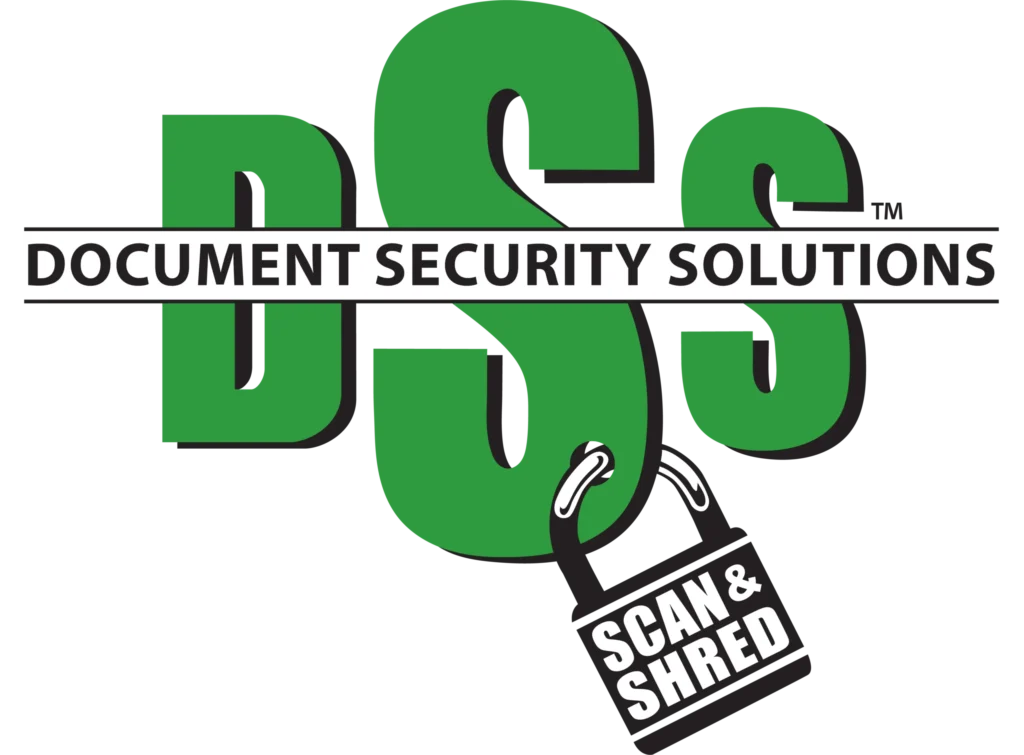Understanding Secure Shredding Fundamentals

Effective secure shredding practices help us protect sensitive information, ensuring data security and preventing identity theft. It’s crucial for us to know what constitutes sensitive and personal documents.
The Importance of Data Security and Identity Theft Prevention
Data security is essential in preventing identity theft. When we dispose of documents without shredding them, we risk exposing personal information. This can lead to unauthorized access to bank accounts, credit misuse, and more.
Shredding ensures that confidential documents are destroyed in a way that makes them unreadable. Security measures, like using a cross-cut shredder, add an extra layer of protection.
By involving family members in understanding these practices, we foster a shared responsibility. Everyone in the household learns to recognize the significance of safeguarding information.
Defining Sensitive Information and Personal Documents
Recognizing which documents to shred is key. Sensitive information includes anything with personal identifiers—social security numbers, bank statements, and tax documents. These documents are targets for identity thieves.
Personal documents may also contain confidential details, like passwords or medical records. It’s vital for us to assess the content and sensitivity of documents before disposal. This helps maintain confidentiality and document security.
Creating a list of these types of documents for family use can aid everyone in knowing what needs shredding. Being proactive in this way strengthens our defense against potential identity theft.
Implementing Secure Shredding at Home

Implementing secure shredding at home helps protect our family’s data and privacy. We need to choose a quality shredder, establish a regular schedule, and educate everyone involved on these practices.
Selecting the Right Quality Shredder for Family Use
When selecting a shredder, it’s important to consider both security and convenience. For our home, we should look for a shredder that offers cross-cut or micro-cut capabilities, as these provide better security than strip-cut versions. These types of shredders turn sensitive documents like bank statements, tax returns, and pay stubs into tiny pieces, making it nearly impossible for anyone to piece them back together.
We should also think about the shredder’s capacity and speed. Many family members may want to shred documents at once, so choosing a model that can handle multiple sheets at a time is ideal. Even features like a jam-proof mechanism or quiet operation can make a big difference in how convenient it is to use regularly.
Good brands will offer basic warranties and reliable customer service. Ensuring we have access to technical support or replacement parts will prevent any future hassles.
Establishing a Shredding Schedule for Household Documents
To maintain security, it’s crucial to create a systematic shredding schedule. We can start by identifying the types of documents we need to shred regularly. Things like monthly utility bills, junk mail, and expired credit cards can be shredded weekly. For more sensitive records like tax documents, we should establish a different timeframe, usually post-filing season.
Having a monthly or weekly shredding day can help keep us organized and ensure documents don’t pile up. We may find it helpful to place a shredder in a common area to remind us to use it consistently. Developing this habit allows us to incorporate shredding into our regular routine, similar to how we arrange for other household cleaning tasks.
Involving everyone in the family with a schedule and easy access to a shredder keeps our home secure and clutter-free.
Educating Family Members on Secure Shredding Processes
Understanding how and why we shred documents is vital. We must educate everyone in our household on what types of documents need shredding. For example, sensitive items like medical bills, passports, and birth certificates should never be disposed of without shredding. Even less obvious items like junk mail with personal information, like pre-approved credit offers, require careful attention.
We can hold a short educational session at home to demonstrate how to operate the shredder. Discussing the risks of improper disposal, such as identity theft, can also help underscore the importance of shredding.
By involving everyone, we create a culture of data security at home. Regular reminders and clear guidelines can help keep shredding practices a shared responsibility among us all.
Professional Shredding Services and Compliance

When it comes to protecting sensitive information, professional shredding services provide reliable solutions. Shredding documents securely ensures that confidential data is disposed of properly.
The Benefits of On-Site and Off-Site Shredding Services
On-site shredding allows us to witness the document destruction process at our location. This can ensure immediate and secure disposal, giving us peace of mind. Trucks equipped with shredders come to us, providing a convenient solution.
Off-site shredding involves collecting documents and transporting them to a shredding facility. Although we don’t see the process, high security is maintained, often at a lower cost. Both options guarantee compliance with data protection laws and offer a certification of destruction.
Choosing between on-site and off-site depends on our specific needs and budget. Factoring in the volume of materials and the need for confidentiality helps us decide.
NAID AAA Certification and Compliance Standards
NAID AAA Certification is a key standard in the shredding industry. It ensures that shredding services adhere to strict security protocols and ethical business practices. This certification means that the shredding company follows industry standards for data protection.
Professional shredding providers with NAID AAA certification assure compliance with data protection laws. They undergo scheduled audits and unannounced inspections, giving us confidence in their services. Certified companies guarantee confidentiality and integrity throughout the document shredding process.
By choosing a certified provider, we can trust that our documents are being handled securely. This certification helps us meet legal obligations and maintain trust with our clients.
Maintaining Privacy and Security in Document Disposal
Maintaining privacy and security in document disposal is crucial to protect sensitive information such as medical records, tax documents, and legal documents. We must focus on creating an efficient document management process, securing documents before shredding, and performing regular audits to ensure effective shredding routines.
Developing a Document Management Process at Home
Setting up a document management process involves organizing and sorting documents. We should decide which records need to be stored and which require shredding. Tax documents, medical records, and legal papers meant for secure disposal must be isolated from regular waste.
A simple home filing system can help us manage important papers. Labels like keep, shred, or review can clarify these categories. By doing this, we can easily spot which documents need immediate attention, whether for safekeeping or shredding.
Securing Documents Prior to Shredding and Disposal
Before shredding, securing our documents ensures they remain safe until disposal. It’s essential to store sensitive records in locked drawers or cabinets. Implementing security measures reduces the risk of data breaches.
Involving everyone at home can create awareness about the importance of secure storage. Using clear guidelines for handling documents such as HIPAA-related files can protect privacy. This proactive approach limits unauthorized access and helps us maintain confidentiality.
Regular Audits for Ensuring Effective Shredding Routines
Conducting regular audits of our shredding routine checks if our disposal methods are effective. We explore whether sensitive documents make it to the shredder without getting misplaced. Spotting inconsistencies can highlight areas for improvement.
Audits help verify adherence to recommended security measures. We track shredding frequency and adjust it based on the volume of records like medical and legal documents. These checks can ensure our routine stays consistent, safeguarding our private information and keeping disposal processes efficient and secure.
Evaluating Shredding Service Providers
When choosing a shredding service provider, it’s crucial to consider factors like reliability, service offerings, and customer feedback. By focusing on these aspects, we can ensure that our family’s shredding needs are met securely and efficiently.
Assessing Reliability through Customer Reviews and Testimonials
To find a reliable shredding service, we need to look at customer reviews and testimonials. These reviews offer insights into other customers’ experiences with the service provider. Positive feedback often highlights efficient secure shredding processes and good customer service.
We should look for reviews on independent websites to avoid bias. By comparing multiple sources, we can gauge the provider’s reputation. A strong track record is usually a good sign.
If there’s a consistent pattern of complaints, it’s wise to reconsider our choice. Testimonials can also be requested directly from the provider. These firsthand accounts help us verify the company’s claims.
The Role of Scheduled Shredding Services for Families
Scheduled shredding services offer families a convenient way to maintain regular secure document destruction. By setting up a routine, we remove the hassle of deciding when to shred documents. This regular schedule assures us that our sensitive information is consistently protected.
Providers often offer different scheduling options, allowing us to choose what suits our family’s needs best. Some may offer weekly or monthly services, depending on the volume of documents we need shredded.
Family members can be involved by gathering papers regularly, which encourages good habits. These scheduled services also save time, as we don’t need to drop off our documents at a location.
Understanding Additional Services like Secure Storage and Product Destruction
Many shredding services offer additional options like secure storage and product destruction. Secure storage is useful for documents we need to keep but want to ensure remain protected.
Product destruction extends beyond paper. It includes destroying items like expired ID cards, hard drives, or even branded products. This helps us manage clutter safely and securely.
Choosing a provider that offers these extra services can be beneficial. It ensures all our destruction needs are under one roof. Plus, it simplifies our processes, making everything more manageable for our family.





